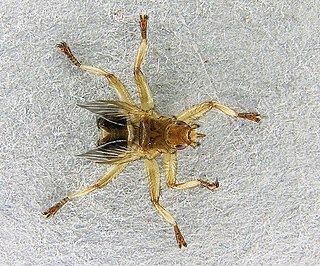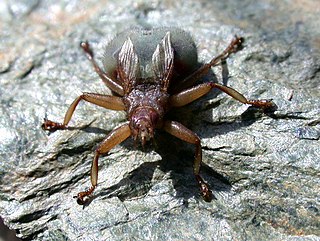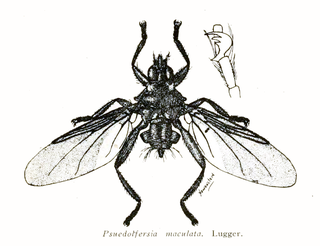
Hippoboscidae, the louse flies or keds, are obligate parasites of mammals and birds. In this family, the winged species can fly at least reasonably well, though others with vestigial or no wings are flightless and highly apomorphic. As usual in their superfamily Hippoboscoidea, most of the larval development takes place within the mother's body, and pupation occurs almost immediately.

Lipoptena is a genus of flies in the family Hippoboscidae, known as louse flies or keds

Crataerina is a genus of louse flies in the family Hippoboscidae. All are parasites of birds, feeding on the blood of various species of Apodidae (swifts) and Hirundinidae. The genus is sometimes spelled Craterina.
Neolipoptena ferrisi, or the Pacific deer ked, is a species of fly from the family Hippoboscidae. They are blood-feeding parasites of the mule deer - Odocoileus hemionus, the white-tailed deer - Odocoileus virginianus & The Pronghorn - Antilocapra americana. They are found from British Columbia, Canada, to Baja California, Mexico. and Australia.
Neolipoptena is a genus of flies in the family Hippoboscidae.
Stilbometopa are genus of biting flies in the family of louse flies, Hippoboscidae. There are 5 known species. All species are parasites of birds.
Microlynchia is a genus of biting flies in the family of louse flies, Hippoboscidae. There are four known species. All species are parasites of birds. Microlynchia differs from Pseudolynchia in the presence of minute ocelli and a differently shaped scutellum.
Ortholfersia is a genus of biting flies in the family of louse flies, Hippoboscidae. There are 4 known species. All species are parasites of macropods.
Allobosca is a genus of biting flies in the family of louse flies, Hippoboscidae. There is only one known species, Allobosca crassipesSpeiser, 1899. It is a parasite of lemurs. It has only rudimentary wings.

Melophagus is a genus of flies in the family Hippoboscidae. All are wingless.
Struthiobosca is a genus of biting flies in the family of louse flies, Hippoboscidae. There is only one known species, Struthiobosca struthionis(Janson, 1889). It is a parasite of ostriches.
Austrolfersia is a genus of biting flies in the family of louse flies, Hippoboscidae. There is only one known species, Austrolfersia ferrisiBequaert, 1953. It is a parasite of Diprotodontia.
Phthona is a genus of biting flies in the family of louse flies, Hippoboscidae. There are 3 known species. All are parasite of falconets of the genus Microhierax.
Myophthiria is a genus of biting flies in the family of louse flies, Hippoboscidae. There are 13 known species. All species are Parasites of birds.
Ornithoctona are genus of biting flies in the family of louse flies, Hippoboscidae. There are 12 known species. All species are parasites of birds.

Olfersia is a genus of biting flies in the family of louse flies, Hippoboscidae. The genus was erected by William Elford Leach in 1817. There are seven known species, and all are parasites of birds.
Ornithophila are a genus of biting flies in the family of louse flies, Hippoboscidae. There are two known species. Both species are parasites of birds.
Proparabosca is a genus of biting flies in the family of louse flies, Hippoboscidae. There is only one known species, Proparabosca alata(Theodor & Oldroyd, 1965). It is a parasite of lemurs.
Crataerina melbae is a species of biting fly in the family of louse flies Hippoboscidae. Its hosts are swift species including the Alpine, Pacific, Common and mottled swifts.
Crataerina acutipennis, is a species of biting fly in the family of louse flies Hippoboscidae. Its hosts are swift species including the little, white-rumped, Horus, pallid and plain swifts.




